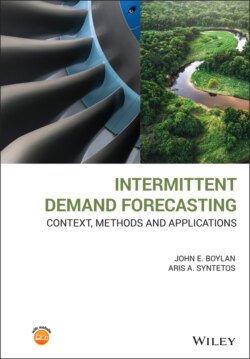Читать книгу Intermittent Demand Forecasting - John E. Boylan - Страница 80
3.5.3 Cycle Service Levels Based on Cycles with Demand
ОглавлениеThe CSL measure is appropriate for non‐intermittent demand but suffers from some drawbacks for intermittent demand. Cardós et al. (2006) gave the example of a product, without any stock at all, facing a demand once every 10 weeks. Even with no stock, there would be no stockouts in 90% of the weeks because there is no demand in 90% of the weeks. If the replenishment cycle is one week, then this would mean that the CSL is 90%. However, as the authors commented, with no stock, there is no service!
Examples such as this motivate the development of a revised method of calculating the cycle service level for intermittent demand items. Instead of looking at all replenishment cycles, we focus on those replenishment cycles that contain some demand. In this book, the revised cycle service level will be denoted as , where the plus sign indicates restriction to review intervals with a positive (non‐zero) demand. Cardós et al. (2006) argued that the usual calculation of demand probabilities would require amendment to recognise this restriction. Teunter and Duncan (2009) also took this into account in their non‐parametric analysis, to be discussed in Chapter 13. Finding will require separate evaluation of:
1 The probability of demand over the review interval, conditional on this demand being strictly positive.
2 The (unconditional) probability of demand over the lead time.
These calculations are illustrated in Table 3.5.
The notation in Table 3.5 is the same as in Table 3.3. The probability in the fifth column is unconditional, and may be written as , as there is no restriction on demand during lead time. The probabilities in the fourth and final columns are conditional, as they are subject to the condition that is strictly positive (), and are written as and , where the vertical lines indicate ‘subject to the condition that’.
In Table 3.5, the review interval (Week 1) and the lead time (Week 2) are considered separately. In the second column, we exclude the possibility of zero demand, as the measure is restricted to review intervals with non‐zero demand. The values in the fourth column have also changed. In the long run, only half of the weeks have non‐zero demands, according to Table 3.2. Therefore, although only 30% of weeks have a demand of one unit, 60% of weeks with some demand have a demand of one unit. Similarly, 40% of weeks with some demand have a demand of two units. The fifth column uses the same probabilities as in Table 3.2 because the possibility of zero demand is not excluded in Week 2. The final two columns in Table 3.5 are calculated in the same way as in Table 3.3.
Table 3.5 Distribution of total demand over two weeks conditional on non‐zero demand in first week.
| Total | Week 1 | Week 2 | Week 1 Probability | Week 2 Probability | Product | Total Probability |
|---|---|---|---|---|---|---|
| 1 | 1 | 0 | 0.6 | 0.5 | 0.30 | 0.30 |
| 2 | 2 | 0 | 0.4 | 0.5 | 0.20 | |
| 1 | 1 | 0.6 | 0.3 | 0.18 | 0.38 | |
| 3 | 2 | 1 | 0.4 | 0.3 | 0.12 | |
| 1 | 2 | 0.6 | 0.2 | 0.12 | 0.24 | |
| 4 | 2 | 2 | 0.4 | 0.2 | 0.08 | 0.08 |
Figure 3.1 Comparison of CSL and .
Now that the conditional probabilities have been calculated, it may be asked if they can be used to estimate . Cardós and Babiloni (2011) pointed out that, strictly speaking, we are interested in the probability that demand over a replenishment cycle does not exceed the stock on hand at the beginning of the cycle. This value would give an exact cycle service level but it is very difficult to calculate and Cardós and Babiloni (2011, p. 64) concluded, ‘The exact method to compute the CSL is not an appropriate procedure to be widely used in a business context’. Consequently, they recommended basing calculations on the cumulative conditional probabilities of demand over the protection interval, in order to estimate the revised cycle service level (). Returning to our example, the results are given in Figure 3.1, and are compared with the original CSL values for different potential OUT levels.
In this example, there is a large difference between the two cycle service level measures, for OUT levels of both one and two units. The difference between the two measures for three units is smaller (96% for CSL, 92% for ) but would lead to a disagreement on the OUT level needed to ensure that a 95% cycle service level target is met. For an OUT level of four units, there is no difference: all demand is satisfied, as the maximum demand over two weeks is for four units (see Table 3.4). It does not matter whether cycles with no demand in the review intervals are excluded or not; there can be no stockouts in either case.
In our example, the calculations were manageable because the protection interval was only for two periods and the OUT level did not need to exceed four units. The calculations can become more involved for longer protection intervals and higher OUT levels, and approximate formulae have been given to simplify the calculations (Cardós and Babiloni 2011). In Chapter 8, we explain how other formulae can be used if the demand follows certain demand distributions. If no demand distributions can adequately represent the real demand, then another option is to use non‐parametric approaches, to be discussed in Chapter 13.
